Reading Time: 18 Minutes
Finding that perfect influencer means understanding your target audience and finding creators who represent them. That means you’ll need an effective vetting process to ensure your demographics, mission, and values align.
Each social media platform is developing more robust ways to track account and content performance. For now, many of those metrics are only available to the creator. But there are other ways to perform your own influencer audience analysis.
It’s not just important that you and your creator have a strong relationship. You also need to know that your influencer team maintains genuine relationships with the right audience members. With that insight, it’ll be easier to tell whether those brand-creator collaborations will have a real, long-lasting impact.=
Your influencer’s audience matters because your ultimate goal is to draw a positive response from their community.
But more importantly, an influencer audience demographics analysis will reveal how deep the relationship runs between a creator and their followers. Many creators reach audiences that engage as many posts as possible, while others have followers who are somewhat apathetic about that creator’s content.
By understanding an influencer’s follower base, you can make better decisions about who you invite into your program. Furthermore, you’ll be able to anticipate campaign ROI based on the quality of the relationship between a creator and their followers.

Most creators attract audiences within a specific age range, ethnicity, location, and lifestyle. Income or education level also plays a role. These data points help you see how well your influencer’s audience aligns with your target audience.
When it comes to influencer authenticity, there are two things to consider:
While spotting and avoiding fake influencers is much easier than it used to be, agencies that sell bot followers and engagements to aspiring influencers are still out there.
Usually, you can spot bot activity through followers that appear to have an inactive profile. Additionally, a high volume of shallow comments (emoji comments) demonstrates that a creator’s audience may not be legitimate.
But even among real influencers, some maintain a following among disinterested users or through means like influencer pods. These pods, for example, are quid-pro-quo arrangements where creators in a group agree to like and comment on one another’s posts to drive impressions and engagements. While this practice is “better” than paying for fake followers and engagements, it’s still misleading.
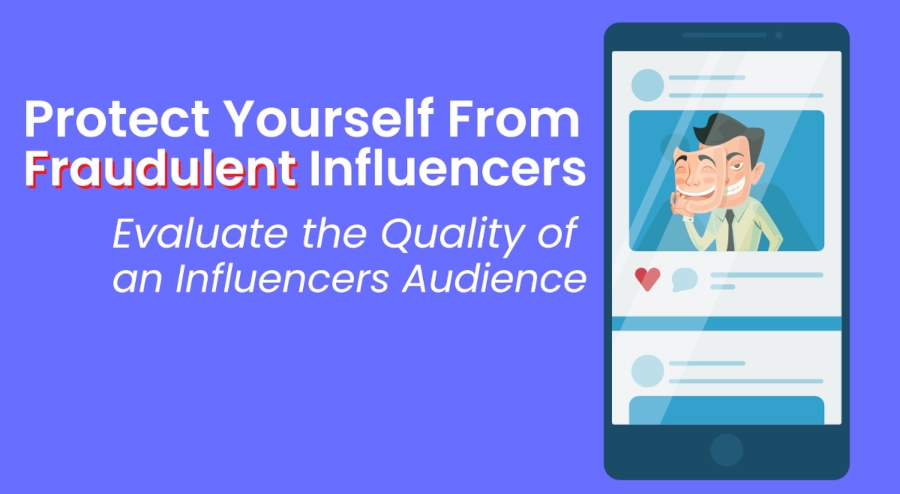
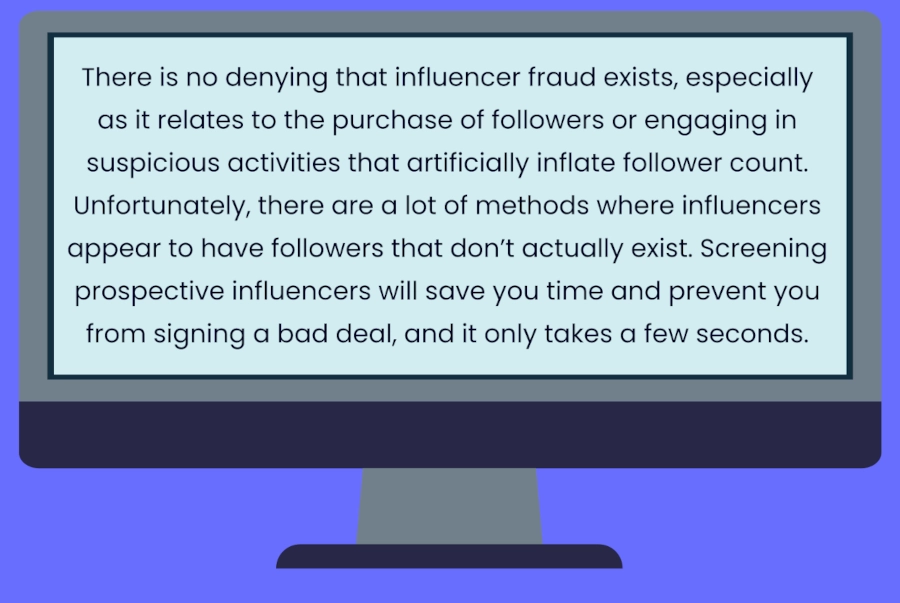
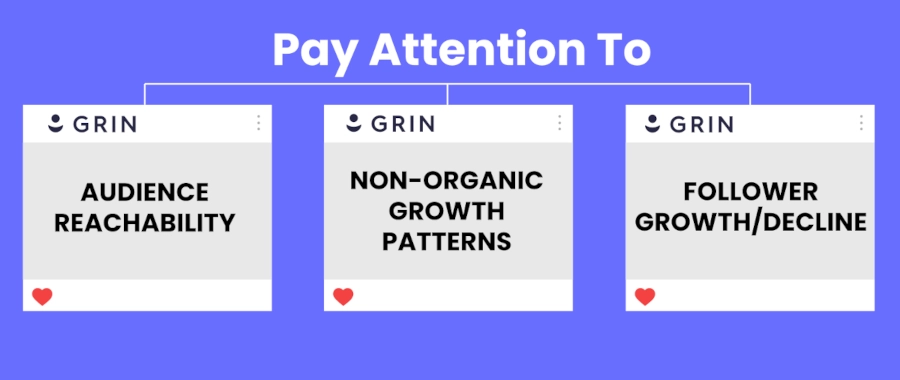
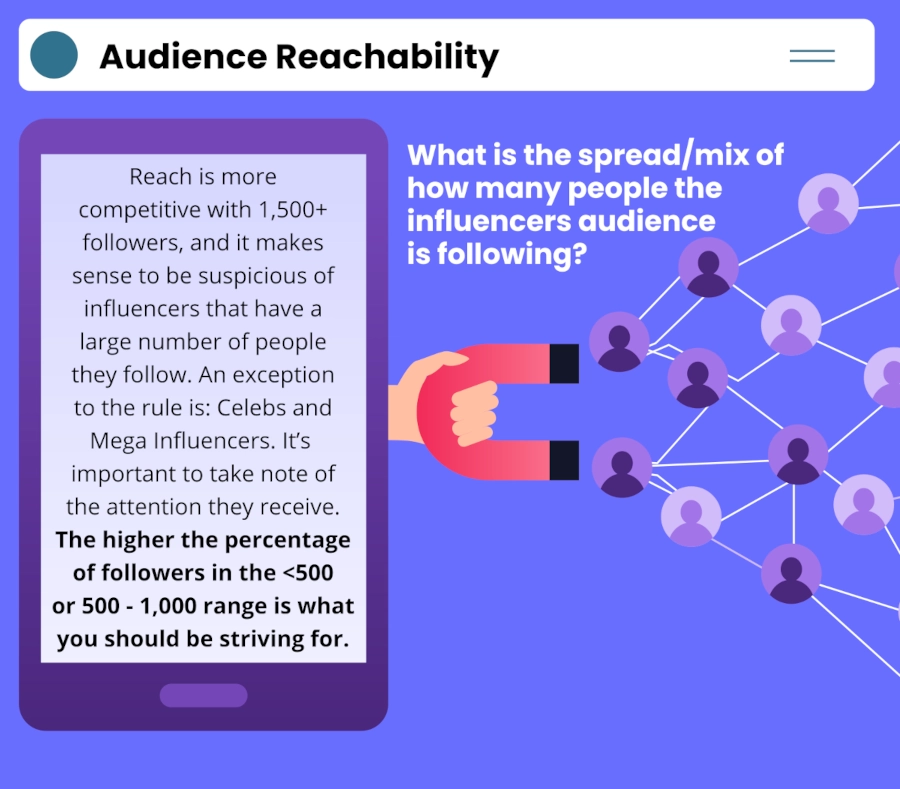



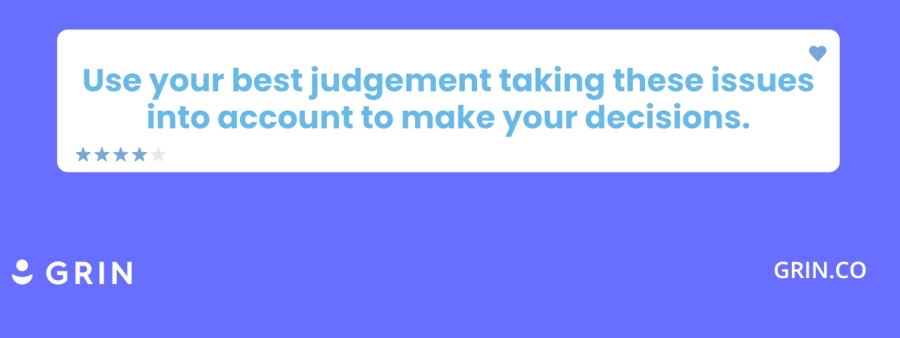
Reachability is the likelihood of an audience viewing a creator’s post. While some of these metrics do depend on proprietary algorithms, many social media users simply follow too many creators to see all of their content consistently.
For example, if a user follows as many as 1,000 friends, family, and creators, they’re less likely to see everyone’s content regularly. Conversely, users following fewer than 500 accounts are far more likely to see and engage with creator posts.
The posts that followers choose to engage, as well as the kind of content they post and their favorite tags/hashtags, will tell you a great deal about their interests and values.
When using creators to help you build brand communities, follower interests and values help you generate authentic content for like-minded consumers. This approach attracts audiences more easily and increases customer loyalty and lifetime value (CLV).
It’s good to know if a creator has notable followers (celebrities, influencers, etc.). Noticing thriving relationships between authentic creators can help you find new prospective ambassadors for your brand.
If both influencer audiences overlap significantly, you can acquire more insight into that creator’s audience.
Reading the comments is one of the best things you can do to evaluate a creator’s audience. Robust creator-follower relationships typically manifest themselves in great conversations within post comments.
Conversations between followers signal the creator knows how to produce valuable user-generated content. Furthermore, influencers that take the time to reply to their followers’ comments greatly enhance follower trust.
See Also: How to Find Content Creators Guidebook
It’s tough to find the right influencer if you’re not 100% confident about who your audience is and its various segments.
Once you’ve established your ideal customer profile (ICP) or buyer personas, be sure to have them handy during your influencer search. These tools are crucial to begin your recruiting process.
You’re far more likely to get better campaign results if you identify 1-3 social channels where your audience is most active. Not only will this help you simplify your workflow, but it will also make it easier to find that perfect influencer.
What you hope to accomplish in a campaign will also dictate which influencers you add to your shortlist. Some creators are better at driving brand awareness, while others are best at boosting sales or website traffic.
Once you’ve identified influencer prospects that match your target audience and campaign goals, you’ll want to set up a way to compare and contrast your options.
Start with a spreadsheet with the following columns to help keep track of your audience information:
The list above is by no means exhaustive, so as you perform your own audience analytics, feel free to add or even remove tabs and columns to your database as necessary.

Image via eMarketer
When evaluating audiences on Instagram, you’ll see engagements in the form of reactions, comments, views, and shares. Currently, IG is most popular among ages 18-34. But depending on your industry, these demographics could look different.
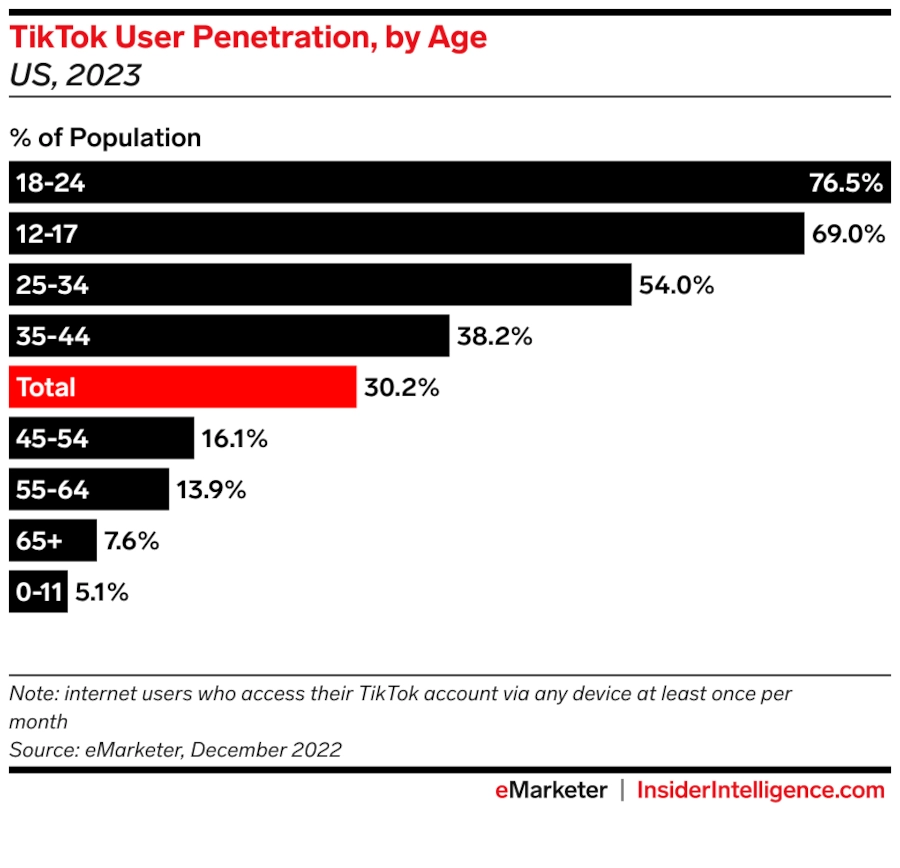
Image via eMarketer
TikTok is one of the fastest-growing social media channels in history. And even though it’s most popular among users under 30, the age gap is closing as older users become more comfortable with the app.
TikTok also has more engagement features than most other channels, including reactions, comments, shares, Q&As, duets, and stitches.
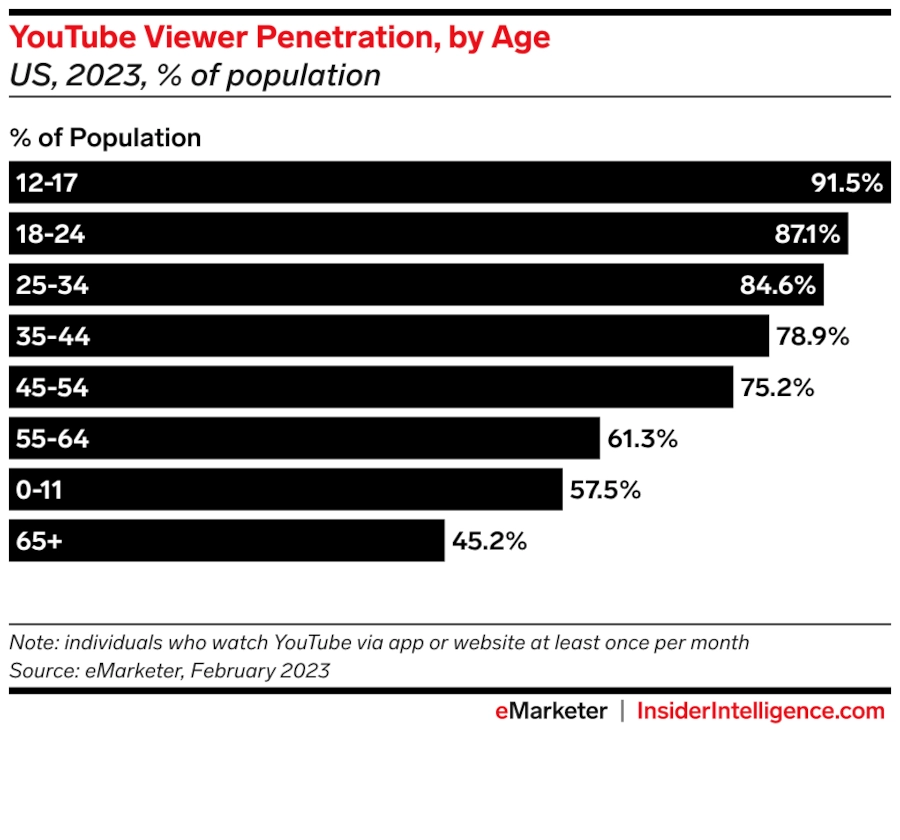
Image via eMarketer
Because YouTube is more than a social network (it also aims to compete with media streaming services like Netflix and Hulu), not only will audience demographics be unique, but audience behavior will also look a bit different.
For example, YouTube is a video search engine much like its parent company, Google. Many users binge their favorite videos, and as such, video completion rates are essential engagement metrics to follow.
Keeping in mind the differences between audiences on various social platforms, you can use this checklist to guide your influencers’ audience analysis on all leading channels.
It’s unrealistic to check every single follower when doing audience analysis manually. Instead, consider pulling a sample from a few recent creator posts.
In this step, you’re mainly concerned about the followers’ legitimacy. If you notice that a few of the creator’s follows and engagements come from fake or inactive accounts, there’s a high probability that the influencer’s “influence” is manufactured.
Followers who are also influencers are known as “notable followers.” Influencers with high-profile followers will tell you more about their interests and values since other influencers/celebrities are typically more open about their lives for the sake of their fans.
If you notice certain notable followers consistently reacting and commenting on one another’s posts, you may have uncovered activity originating from an influencer pod. If you suspect this to be the case, you should take a closer look to confirm the activity and consider that before recruiting any of those influencers.
Next, pull a sample of the creator’s followers and see how many accounts those individuals follow. If many follow 1,000 or more other accounts, then that means that the creator’s reachability is low. In other words, there’s a low probability that those followers even see the creator’s posts in their feeds.
Fans that follow fewer than 500 accounts are most reachable, particularly on Instagram, TikTok, and Facebook.
From that same sample, try to identify the followers’ attributes, such as age, gender, interests, and values. Note how well these characteristics match your buyer personas.
Many followers are open about their favorite brands. They may indicate which brands they like by hashtag usage, post comments, or within the content on their own pages.
An engagement rate is a good metric to understand how active a creator’s followers are. To find engagement rate, divide the creator’s total number of likes, comments, and shares by their follower count.
Engagement Rate = Total # of Post Engagements / # of Followers
You can also use one of the following formulas below, depending on your campaign goals and KPIs:
Engagement Rate = Views / Reach
Engagement Rate = Interactions / Views
Engagement Rate = # of Comments, Shares, etc. / Total Post Likes
Don’t feel like doing the math? Download GRIN’s free Web Extension to analyze creator profiles in seconds.
Most high-performing influencers take extra effort to reply to follower comments and encourage ongoing user-generated content. If you consistently see vibrant, positive discussions within a creator’s post comments, you can feel good about the relationship between the creator and their audience.
Try to see how organically a creator can introduce brands and products into their content. By searching for sponsored posts, you can compare/contrast how readily that influencer’s fans accept the creator’s product endorsements.
Creators that struggle to get follower engagement on sponsored posts may not genuinely love the products that they promote, or they may struggle to introduce their favorite brands organically.
It’s critical that you gather as much information as you can and record it into a spreadsheet. Evaluating an influencer’s audience is hard work, and by saving your insights, you’ll be able to make your efforts count as you examine more prospects on your list.
Marketers can’t fake authenticity and trust. These benefits are earned by individuals that place a premium on quality content and relationships. Just as you want to nurture genuine relationships within your creator team, your influencers must maintain quality connections with their audience members.
Performing an influencer audience analysis can help you confirm your influencer prospects are doing just that—curating an online community of engaged fans that will easily become loyal customers for your brand.
Learn more about influencer marketing: Influencer Marketing 101
Our team keeps a finger on the pulse, so you’re always working with the latest information.